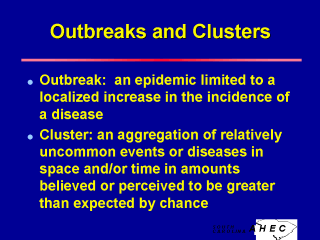| front |1 |2 |3 |4 |5 |6 |7 |8 |9 |10 |11 |12 |13 |14 |15 |16 |17 |18 |19 |20 |21 |22 |23 |24 |25 |26 |27 |28 |29 |30 |31 |32 |33 |34 |35 |36 |37 |38 |39 |40 |review |
 |
Outbreaks generally involve infectious disease. The problem is unexpected; an immediate response may be demanded; public health epidemiologists must travel to and work in the field to solve the problem; and the extent of the investigation is likely to be limited because of the need for timely intervention. A cluster usually refers to a uncommon diseases of noninfectious origin (e.g., leukemia, spontaneous abortions, suicides) which are often perceived to be due to environmental exposures. Cluster studies are sometimes called “small area analyses” because they typically are carried out at a subregional level at which routine reporting of disease rates is unlikely. |